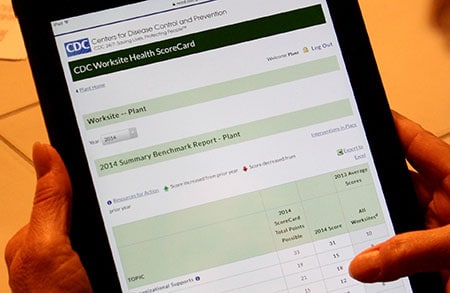Here are some simple ways to start your workplace wellness program and suggestions to offer to individual employees to be healthier.
Set up active work stations like standing or treadmill desks. Sitting for long periods has been linked with a higher risk of obesity, cancer and cardiovascular disease.1
Provide access to a sleep wellness program. According to research done by the Harvard Medical School, people who don’t get enough have difficulty focusing, pay attention and receiving new information.2
Encourage employees to use active transportation to work. Walking or biking to work is an easy way to promote an active lifestyle, which helps reduce obesity and chronic disease.
Offer flexible work schedules to allow for fitness throughout the day. For example, encourage employees to take an hour lunch break so that they can go to the gym, or let employees come in later so they can make their favorite gym class.
Make water available and easily accessible for employees. Having water available will encourage others to drink water by offering the choice of a healthy alternative.
Establish a healthy eating policy regarding the food offered at events. A healthy eating policy not only helps your attendees eat a little healthier but establishes that health is a priority for your chamber.
Create a policy banning tobacco and tobacco products from the office and events. Tobacco has been found to not only be harmful to the user but the people around them. Having this policy in place will reduce your employees’ exposure to second-hand smoke.
Include coverage of hypertension, cholesterol, and blood glucose tests in your health benefits package. Including coverage removes the barrier of affording regular doctor visits and tests.
Lead by example. Businesses will be more likely to follow if the chamber is making workplace wellness a priority.
Health is gaining traction as a critical issue in today’s workplace. Worker illness and injury cost employers $225.8 billion annually.1 Obesity costs $1.42 trillion in both direct (healthcare) and indirect (absenteeism) spending.2 The total economic burden of major depressive disorder is an estimated $210.5 billion per year.3 Chambers of commerce and business associations are increasingly promoting and supporting the implementation of employer-led innovative workplace programs and policies that encourage employees to adopt healthier lifestyles.
The benefits of workplace wellness initiatives far outweigh their cost. A study by the Rand Corporation studied the costs and benefits of disease management and lifestyle management, workplace wellness programs. Disease management programs offer an average of $3.80 ROI, and there are greater short-term benefits. In comparison, lifestyle management programs offer an average of $0.50 ROI, and there are greater long term benefits.4 Not only do these initiatives help employees adopt healthy work-life habits, but they also produce more productive employees, help attract and retain talent, build staff morale, combat employee absenteeism, minimize staff turnover, and reduce healthcare costs for employers—and ultimately improve the bottom line for businesses.

Chamber's Roles in Workplace Wellness - ACCE webinar presented by Emily Counts, ACCE; Joe Hurd, Blair County Chamber of Commerce (PA); Matt Beatty, Greater Des Moines Partnership (IA) (Dec 19, 2018) - This webinar showcases how chambers across the country have launched successful workplace wellness programs. You will hear from large and small chambers about how these programs can be done at any level. Learn how you can engage your members and encourage them to be fit and active within your community.








Association of Chamber of Commerce Executives
1330 Braddock Place, Suite 300 | Alexandria, Virginia 22314
703-998-0072
©2019 | Privacy Statement | Disclaimer
Facebook Twitter Instagram